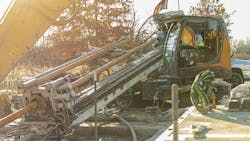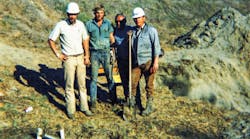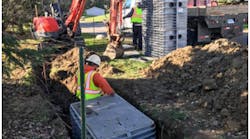A Comprehensive Look at Horizontal Directional Drilling in Utility Installations
In today’s high-demand energy sector, utilities and infrastructure developers face increasing pressure to deliver projects more quickly while minimizing disruption to the environment and surrounding communities. Horizontal Directional Drilling (HDD) has emerged as one of the most widely used trenchless methods to meet these challenges, offering a practical solution for efficient installation to install underground utilities such as electric conduits and cables, pipelines, water and sewer mains, etc. Although HDD installation can be extremely challenging, its value is undeniable when applied with careful planning, precision application, and the right technical knowledge.
A Closer Look at Horizontal Directional Drilling (HDD)
HDD is a trenchless method used to install pipelines, conduits and cables beneath roadways, bodies of water, rail lines and other hard-to-access or environmentally sensitive locations. The technique enables construction teams to maintain continuity of surface infrastructure while placing underground assets along a predetermined path.
The process consists of three critical phases:
- Pilot hole drilling: A steerable drill head is pushed along a carefully engineered path guided by real-time tracking systems that limit deviation and support corrections spontaneously.
- Reaming: After the pilot hole is completed, it is enlarged using a reamer. The reamed diameter typically exceeds the product pipe size by a factor of 1.5 — or approximately 12 inches larger and is determined using the product pipe diameter.
- Pullback: In the final phase, the product pipe is pulled through the reamed path using a swivel and pullhead. This operation should proceed without interruption to reduce the potential for settling of cuttings or gelling of drilling fluid around the pipe, which can increase resistance and interrupt installation.
HDD is particularly advantageous where open-cut trenching is impractical or prohibited — such as beneath rivers, railroads and highways; within urban corridors; under existing utility networks; or in environmentally sensitive areas. Although the upfront costs may be higher, the long-term benefits often outweigh the investment.
Evaluating Feasibility Before Breaking Ground
Thorough feasibility assessments are critical, as HDD often involves significantly higher capital costs than conventional open-cut installation. A key part of this evaluation is determining whether the installation supports a transmission or distribution system, as this distinction drives decisions on pipe or conduit material, diameter, and installation requirements. Steel pipe is widely used for oil and gas transmission due to pressure and structural demands. However, for HVAC or HVDC cable installations, non-ferrous
materials such as HDPE, PVC or fiberglass-reinforced polymer are typically preferred to avoid adverse thermal and electrical interactions. Distribution systems — whether for gas or cable — generally involve smaller-diameter conduits like polyethylene or PVC, depending on the application and local standards.
Obstruction identification is another essential step - especially under navigational waterways, levees, railroads or highways where trenchless methods may be the only viable option. Subsurface composition, whether bedrock, alluvial deposits or a mixture of soils, significantly affects constructability and risk.
Access and workspace limitations also must be assessed, alongside any permitting requirements that could delay the project. The potential for excessive noise generation during HDD can become a barrier during permitting if not mitigated through early modeling and temporary noise control measures. Engineers must also factor in potential seasonal considerations or environmental regulations that could restrict work windows or require additional coordination.
A comprehensive feasibility evaluation should culminate in a go/no-go recommendation to help vested parties decide whether to proceed into detailed design or to evaluate alternate installation methods.
Translating Strategy into Execution
Detailed design begins with a preliminary desktop evaluation and site reconnaissance. Engineers review available information about surface features, subsurface conditions and overhead constraints to understand the surrounding environment, including the presence of existing structures or underground utilities. A conceptual plan and profile are prepared, and drill rig size is determined based on estimated pullback loads using the drill length and product pipe diameter. Sufficient space must be allocated for pipe stringing including ingress and egress, turnarounds, mud recycling systems, ancillary equipment and laydown/storage.
Environmental permitting is initiated in the early design phase, especially in protected zones, as approvals can take several months. A site-specific geotechnical investigation is critically important and goes beyond a preliminary desktop study, which typically rely on publicly available maps such as United States Geological Survey (USGS), soil surveys and water well logs. The site-specific investigations involve fieldwork, such as drilling boreholes and performing laboratory testing to gather detailed information about subsurface conditions. Site-specific soil borings reveal potential challenges such as presence of perched groundwater, boulders, cobbles, gravel, or coarse-grained soils that increase the risk of fluid loss or equipment wear.
The profile geometry is refined using the civil topographic survey and soil boring logs; adjusting the bend radii, entry and exit angles, and depth to align with appropriate soil layers conducive to the installation.
Engineers use integrated design software to simulate proposed design and identify potential trouble spots before construction begins. A shallower exit angle is highly recommended for larger pipe diameters to ease pullback and minimize the pullback forces and resulting stresses. An inadvertent return (IR) analysis is also performed utilizing the Delft Equation per the guidance provided by the United States Army Corps of Engineers (USACE) to predict where drilling fluids might lead to fracture the soil and unintentionally surface of the drilling mud unintentionally. Based on the IR analysis results, the proposed design is further modified to minimize the potential for any inadvertent returns. Finally, stress analysis confirms that the pipe can sustain the forces experienced during installation and due to long-term operational demands.
Read More
Trenchless Technologies in Urban Environments
Urban deployments of HDD require careful adaptation. High population density, underground congestion and variable soil conditions make these projects especially complex. Project success depends on coordination with utility owners and municipal agencies, accurate identification of underground utilities using noninvasive methods, and proactive communication with local businesses and residents. Noise and dust control plans, along with traffic management, help limit construction disruption and maintain positive community relations.
Other mitigation measures — such as performing work at night or in off-peak hours or sequencing multiple activities to reduce time on-site — can reduce impacts on busy areas. Community outreach and consistent project updates also help address concerns from property owners and improve the overall perception of the work.
These strategies not only facilitate smoother execution but also build goodwill in neighborhoods with low tolerance for extended disturbances.
Managing Risk Beneath the Surface
Despite its advantages, HDD carries inherent risks. Without proper drill path modeling and annular pressure analysis, drilling fluid may escape into nearby waterways, potentially affecting water quality. Surface subsidence and damage to adjacent infrastructure can result from poorly designed alignment, inappropriate geotechnical assessment or poor execution. Inaccurate or incomplete utility mapping increases the likelihood of potential conflicts or accidental strikes, which may lead to safety hazards and service disruptions. A limited understanding of subsurface conditions can introduce complications during drilling, often leading to construction delays and escalating project costs.
These risks can be mitigated by involving experienced trenchless engineers early in the project life cycle. Such professionals play a vital role in selecting the most appropriate trenchless method, conducting in-depth site investigations, developing risk mitigation plans, and overseeing compliance with permitting and environmental requirements. Contingency planning can be helpful, allowing teams to react quickly to unexpected drilling conditions or tool failures. Choosing an experienced design professional strengthens technical planning and analysis, improves execution and supports successful delivery.
Successful trenchless projects often feature close collaboration among engineers, contractors and project owners during the design phase. This integration fosters realistic scheduling, clear scope definition and the ability to respond quickly to any unforeseen circumstances in the field. It also promotes innovative problem-solving, such as combining multiple obstructions into a single HDD crossing or selecting modular precast splicing vaults to streamline transitions.
Early collaboration often reveals opportunities to optimize construction planning, share access routes among project teams or reduce redundant mobilization. These efficiencies can lead to an improved budget and favorable schedule outcomes.
Trenchless technologies, particularly HDD, are transforming how underground utilities are designed and delivered. As the demand for resilient, sustainable infrastructure grows, embracing trenchless solutions early in project development can help project teams stay ahead of challenges, control costs, and deliver lasting value to the communities they serve. With proper planning, technical knowledge, and collaboration, these methods can reduce surface disruption, improve long-term outcomes, and unlock complex installations in otherwise inaccessible areas.
From the dense urban grid to sensitive wetlands, the right trenchless approach — applied with technical rigor and early collaboration — can make the difference between a project that stalls and one that succeeds.
About the Author
Kerby Primm
Kerby Primm is associate technical consultant at Burns & McDonnell.
Lalit Chilana
Lalit Chilana is associate pipeline engineer at Burns & McDonnell.


